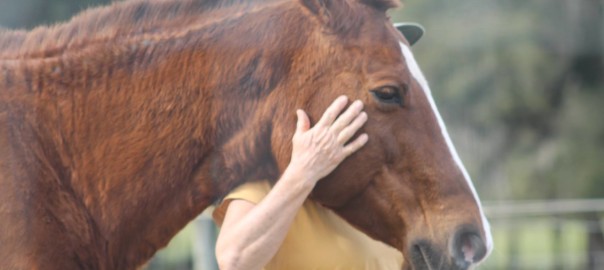Liberty Foundation Training for horses is the most subtle kind of work you could be doing with a horse. Because it is so subtle, sometimes its purpose can be missed.
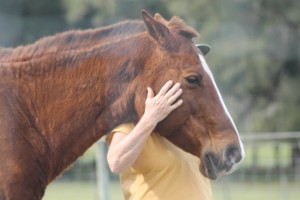
Why people come to class can vary:
“My horse is remote and I want a better relationship with him.”
“My horse doesn’t respond well to traditional training methods.”
“I don’t ride anymore but I want something I can do with my horse to deepen my relationship.”
“I want to be able to catch my horse.”
“My horse is fearful.”
“My horse is aggressive.”
“I think I already do some of what you do but I want to see what you do.”

When they get to class, often they see how simple it is initially, as we do quiet things and we do them as horses do them. Move them off hay, sit with them, ask them to look at us, etc. We have codified herd behavior to work in keeping with what language the horse understands.
And then the people would like to know what else there is?
The clinics and private lessons are about establishing Foundation training and in so doing, creating a real working connection. From the initial six Foundations the horses can be taken on to do additional activities, some of which may be covered in a two-day clinic if we have horses who are ready to embrace them.
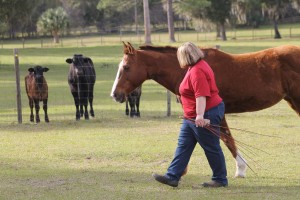
The Foundations are dynamic, not static. We as people are goal-oriented, so we think of how high we can jump and how much easier it will be to catch our horse now that we have the Foundations on them. We want a list that we can check off, then after that’s accomplished, we sit waiting for results.
The Foundations are remarkable in that they expose behaviors. This can be done in more forceful ways with other horsemanship techniques, but the way the Foundations do it, you really learn to know the horse through an evolutionary process.
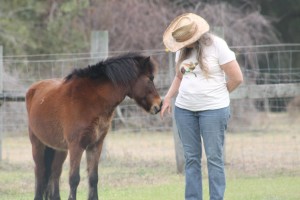
They also expose our weaknesses and our strengths as people working with horses. One of the things that is so important for us to do is the sitting meditation with horses (I ask students to do this before arrival) so that we drop our agendas – our neediness, our expectations, etc. This makes all the difference in the world to the work we do with our horses.
At this recent clinic in Florida, a Tennessee Walking Horse named Penny came into the arena and ran around wildly. I’d tried to work with her last year but then she was new to the barn and frightened of separation from the herd. This year she ran the same way, but she then hung around the fence, hoping to get let back out with the others.
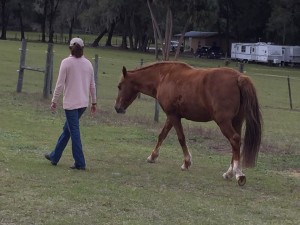
In order to engage her, I placed small piles of hay very close together along the fence line, so she wouldn’t have to go far from that place. I chatted to her the whole time. I was meeting her where she was, rather than expecting her to come out to the center of the pasture to work with me. In a short time she had settled down and become curious about the small piles. I was able to walk her down from this position and then that transitioned to walking beautifully side by side.
Everyone was ultimately able to work with this mare. Each person brings something unique to the horse and the horse learns to adjust his or her energy to the new relationship.
By the second day, Penny was doing a more complicated advanced exercise, the Prairie Flower. We did all the Foundations except “Staking a Claim” with her, because she didn’t need that one. Her demeanor is very soft and engaged, once we found a way to engage her on the first day. She is now an excellent liberty teaching horse.
Where we meet the horse is ultimately so important. Most horsemanship methods are human-based, and what I mean by that is that the human is designing things for the horse to do, according to what the human ultimately wants to do with the horse. So, the round pen, for example, while an ingenious invention, allows the horse to be run around in a prescribed circle until he has become compliant and then he is invited into the center where the human stands. There are few situations where a horse would run around in a circle in the wild, he might do so to round up his herd, but that wouldn’t be nearly as many revolutions as a human expects. The human isn’t thinking about any of that and that’s where the trouble begins.
In the second example, a 20-year-old sorrel grade mare, Cherokee, was shut down to humans in certain ways and very dominant, although we learned the day before that she really loved bodywork!
She was very interested in the hay piles I put out but was difficult to move off hay. Once I got Cherokee moving off the hay, she showed her big stride and we moved into side-by-side walking very naturally. Many people were able to work with her, helping to build and sustain rhythms with her, and she fully enjoyed it.
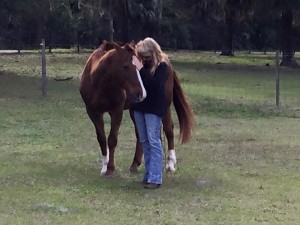
The next day I decided to claim the one hay pile with her, as she was very dominant and I felt it was necessary in her training. She showed her fight reflex: stood right on the hay pile and kicked out while I stood a safe distance away. I moved her quickly, much to her indignation, but it wasn’t long before she came into relationship nicely and we were able to even get a good “Go and Come to Me” draw from her. Thus, we had all the Foundations on Cherokee and she could advance to another exercise, the “Whoa and Wait.” She excelled at that as well.
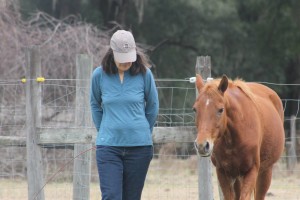
The two ponies, Amber and Cocoa, were back this year, with Amber still completely inseparable from Cocoa. With horses this insecure, we work with them together, again, meeting them where they are. They became comfortable enough to graze across the pasture from one another, and not have to be right next to each other.
The main challenge with these two, as with the rest, was engagement. Cocoa is a driving pony and does his job beautifully, yet he hasn’t been engaged in liberty because everyone is pleased with his performance with the cart. But he is quite smug and unengaged. We were able to get many Foundations on the pair, and played some fun carrot exercises. Ultimately, Diane, Cocoa’s caretaker, spontaneously began to trot with him.
So here’s the rub: the horse is doing everything you want it to, why do liberty?
Because you may not know what horse you have. You can have a true caretaking horse with the correct application of Liberty Foundations, rather than one who will do what is asked but may have no joy in it. You may also expose unwanted or wonderful behaviors that you wouldn’t have known about without the Foundations.
Cocoa demonstrated his pure playfulness and joy at having Diane trot with him. Previously, it looked like he mischievously thought, oh, I can get the humans to leave me alone by trotting off. Imagine his surprise when she began trotting with him. What fun! You now have a more engaged pony – voila!
You don’t know what horse you have if you stay in the box of your own expectations. Simple as that. It’s both simple and difficult. If you don’t meet them where they are, where they live in their body, mind and soul, then you will never know.
Anne Daimler, coordinator and hostess, had this to say about the clinic:
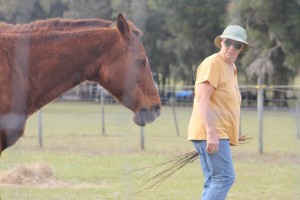
“We had a great clinic this weekend with Susan Smith and Horses at Liberty Foundation Training. Penny (shown in the video) had a major breakthrough in her trust issues. When she first came into the paddock, she spent at least 5 minutes treating us to a wild west show. We couldn’t get near her at last year’s clinic and, throughout the year, although perfectly friendly on a day-to-day basis, Penny would keep her distance when her mom, Gabriele Hofmann, and I would spend time with her. This is VERY subtle work, but the rewards are immense. A horse who was unable to completely trust humans has learned that it is okay to trust again — and even fun! I am looking forward to having Susan back next year for another clinic.”
Videos from our Florida clinic:
(c) Susan Smith, OrthoHorse, Horses at Liberty Foundation Training, Equine Body Balance (TM)
Please see my
Events for information on upcoming clinics and workshops.



